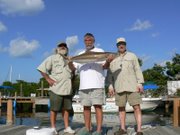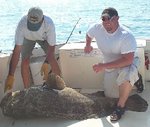Basic Stuff
I have been planning on reorganizing the blog for about 5 years now. It'll wait. I do want to add a few things I recommend in emails to customers.
Gear: I recommend a 20 pound class spinning outfit with clear mono if possible for most general fishing. That should have a line capacity of ~200 yards. 15 to 25 pound is fine if that is what you have.
For trolling, bottom, shark etc. I recommend 30 to 60 pound conventional outfits with line capacity greater than 300 yards. I also recommend clear mono because of the versatility.
leader material. 30# and 80# monel wire for toothy critters and 15# to 60# mono and/or flouro for not so toothy critters.
Hooks: you need a fairly large assortment of sizes from 10 for bait to 7/0 for offshore. 10,4,2,2/0,4/0 and 7/0 are pretty basic in J hooks. For circles, 7/0 and 11/0 thin wire cover most situations. Sabiki rigs size 8 or 10 can be useful, but most often single hook bait rigs.
Note that doesn't mention weights. I use mainly smaller egg sinkers, 1/4 oz to 1 oz on something called a knocker rig. All that is an egg sinker on the line with a hook sized for the bait. The eye of the hook needs to be large enough that the egg sinker doesn't slide down the shank. The lead can slide on the line so that you can let a fish run without feeling the weight very much and once you get the hang of it you can let the bait slide a ways from the lead just like there is a leader. Note also that clear mono works best with this rig and means less work re-rigging. If you like making catching more like work, by all means use something more complicated.
Without the weight you have a freeline rig. That's sports fans, you tie a hook on you line and fish. This also is much easier with clear mono on your spool. If you are a braid fan just add a leader about as long as the depth you are fishing. That sounds like work to me so I use clear mono.
On occasion you may need a little more than just a hook for freelining. Small pinch weights or very small jig head can come in handy. On other occasions you might need a short length of thin wire, that would be the 30# or 40# monel which is a type of stainless steel. For that you need to know a haywire twist and either an Albright, Dog Knot or you can add small barrel swivel. By small I mean size 10, which is about the smallest I can see to get the line through. If my eyes were better I would go smaller. The reason for small is when freelining you want to control the sink rate as you let the line run freely with the current. Get it? Run freely with the current aka freelining. This is so you bait drifts and sinks about the same rate as that expensive chum you have in a landing net size chum bag drifts.
The landing net chum bag is mainly for deeper water, over 40 foot deep. If you want to catch fish cheap you can fish shallower and use a smaller mesh bag. If you want to fish real cheap, stick with the knocker rig and just fish some sexy bottom.
There is a lot of great bottom in the Keys. One of my main lessons is showing folks how to use their bottom finder so they can tell bottom from sexy bottom. Sexy bottom has more profiles, that would be ups and downs with more blur, that would be fish and sea fans and hopefully lots of fish suspended off the bottom blur. If you know your bottom machine real well, you can tell to a point what kind of fish you are marking provided you know a bit about the habits of Keys fish.
On the rock piles, that would be piles of rock typically in Hawks Channel, in 20 to 20 foot you can have a variety of very high quality eating fish, Snapper, Lanes, Mangrove, Mutton, Yellowtail; Hogfish; Porgies, several flavors; Grouper, Black, Gag and Red mainly; Toro or big Eye snapper which aren't bad; Triggerfish; Grunts if you are into panfish, but don't expect to impress many at the dock with your catch plus the occasional Mackerel, Cero, Spanish or King; Cobia; Permit; Pompano and likely a half dozen more. Other than that the rockpiles are pretty boring.
On the patches, that would be patches of coral just inside the reef proper in 20 to 30 foot of water, you have the same critters plus a few more like Schoolmaster Snapper to replace the Lanes and pelagic fish that tend to get lost fairly often in the summer.
On the reef proper, that would be in the 40 to 100 foot range, you pretty much have one stop shopping if you have plenty of chum, a decent current and some patience. This seems to be my favorite older guy fishing spot. You don't have to burn much gas and only have to pull the anchor once while you catch plenty for dinner and have a shot at anything up to and including sailfish.
All of these start with finding that sexy bottom, knowing your current, having fresh and a variety of bait, along with very basic terminal tackle. As far as bait, fresh is best and live is fresher. That means you are ahead of the game with a working live well, a cast net and some starter live bait like pinfish, pilchards, shrimp or any number small bait including crabs.
Catching bait would be my second main lesson. Sabiki rigs are great for some things but it is hard to beat a single size 10 long shank hook and a pinch weight with a tiny bit of bait. Squid tentacles make great bait and believe it or not that bag of fake blood worms you never found a use for also work quite well. I had a bag of those blood worms last me about two years, that is how small you need to cut the bait. If you remove the pinch weight and add a very small float, you have a balleyhoo rig. You use that to catch the ballyhoo until they get stupid enough to throw a cast net over. Stupid ballyhoo are close to the boat and on the surface so you can reach them and when they spook the jump up into the net instead of diving under the net.
If you go out without bait thinking you will catch plenty, you will probably learn about Murphy's law. So to avoid Murphy, take some frozen or fresh balleyhoo, shrimp and in a pinch, squid to make sure you are fishing.
I have my issues with squid other than pinfish bait. It seems anytime I break out the squid the trash fish come running. That is probably just me, but I recommend very judicious use of the Calamari. If you are targeting Yellowtail Snapper and have the big bucks, Silversides aka Spearing are a fantastic bait. If you are cheap like me, thin bait strips made from balleyhoo or other white bait make a great Silverside imitation.
In mainly calm weather, rolled oats make a great chum enhancer. The oats sink more slowly bringing the fish closer to the surface and your boat. The object of chumming is to bring fish to the boat and out of the bottom where the bigger ones tend to break you off. The oats are mainly for the Yellowtail which sometimes forget to read my posts. On an average Yellowtail day they come up pretty quick and you limit out in a couple of hours. For some folks average means never seeing a 'tail, which is likely due to not finding sexy bottom, not having a decent current, not having fresh bait and/or fishing with too much weight or that wonderful braided line.
Now I am going to put this post under fishing basics and knocker rig so more people can find it.
Marathon in the Florida Keys should be your next fishing vacation destination. Join us for charter fishing, fishing guide trips or our fishing 101 so you can fish on your own with better success.
Tight lines,
Capt. Dallas



No comments:
Post a Comment